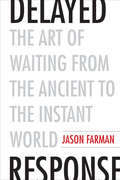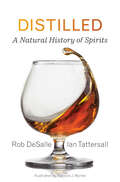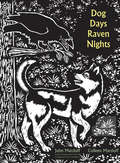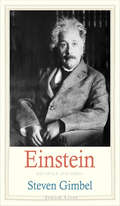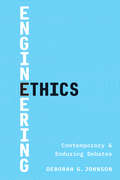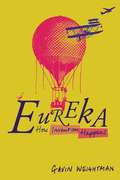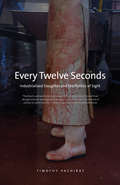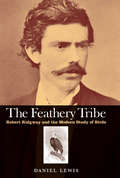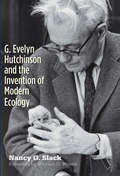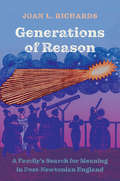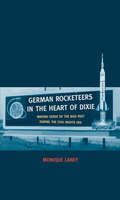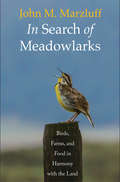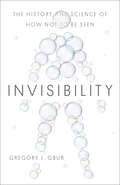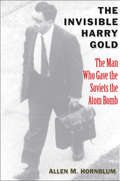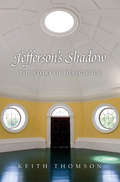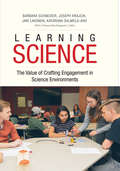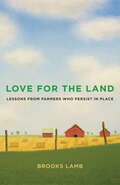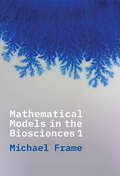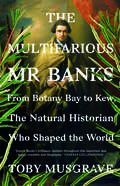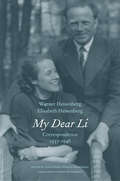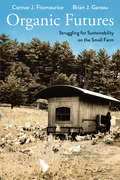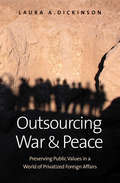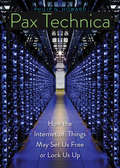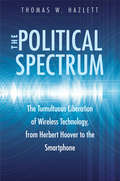- Table View
- List View
Delayed Response: The Art of Waiting from the Ancient to the Instant World
by Jason FarmanA celebration of waiting throughout history, and of its importance for connection, understanding, and intimacy in human communication We have always been conscious of the wait for life-changing messages, whether it be the time it takes to receive a text message from your love, for a soldier’s family to learn news from the front, or for a space probe to deliver data from the far reaches of the solar system. In this book in praise of wait times, award-winning author Jason Farman passionately argues that the delay between call and answer has always been an important part of the message. Traveling backward from our current era of Twitter and texts, Farman shows how societies have worked to eliminate waiting in communication and how they have interpreted those times’ meanings. Exploring seven eras and objects of waiting—including pneumatic mail tubes in New York, Elizabethan wax seals, and Aboriginal Australian message sticks—Farman offers a new mindset for waiting. In a rebuttal to the demand for instant communication, Farman makes a powerful case for why good things can come to those who wait.
Distilled: A Natural History of Spirits
by Rob DeSalle Ian TattersallAn imaginative natural history survey of the wide world of spirits, from whiskey and gin to grappa and moonshine In this follow-up book to A Natural History of Wine and A Natural History of Beer, authors Rob DeSalle and Ian Tattersall yet again use alcoholic beverages as a lens through which to gain a greater appreciation of natural history. This volume considers highly alcoholic spirits in the context of evolution, ecology, history, primatology, molecular biology, physiology, neurobiology, chemistry, and even astrophysics. With the help of illustrator Patricia Wynne, DeSalle and Tattersall address historical and cultural aspects and ingredients, the distillation process, and spirits and their effects. They also call on an international group of colleagues to contribute chapters on brandy, vodka, tequila, whiskies, gin, rum, eaux-de-vie, schnapps, baiju, grappa, ouzo, and cachaça. Covering beverages from across the globe and including descriptions of the experience of tasting each drink, this book offers an accessible and comprehensive exploration of the scientific dimensions of spirits.
Dog Days, Raven Nights
by John M. Marzluff Colleen MarzluffTwenty years ago, fresh out of graduate school and recently married, John and Colleen Marzluff left Arizona for a small cabin in the mountains of western Maine. Their mission: to conduct the first-ever extensive study of the winter ecology of the Common Raven under the tutelage of biologist Bernd Heinrich. Drawing on field notes and personal diaries, they vividly and eloquently chronicle their three-year endeavor to research a mysterious and often misunderstood bird--assembling a gigantic aviary, climbing sentry trees, building bird blinds in the forest, capturing and sustaining 300 ravens as study subjects, and enduring harsh Maine winters in pursuit of their goal. They also shared the unique challenges and joys of raising, training, and racing the sled dogs that assisted them in their work. Accompanied by Evon Zerbetz's lovely linocut illustrations, Dog Days, Raven Nightsis a fascinating, behind-the-scenes look at the adventures of field science and an insightful exploration of the nature of relationships, both animal and human.
Einstein
by Steven GimbelIs relativity Jewish? The Nazis denigrated Albert Einstein's revolutionary theory by calling it "Jewish science," a charge typical of the ideological excesses of Hitler and his followers. Philosopher of science Steven Gimbel explores the many meanings of this provocative phrase and considers whether there is any sense in which Einstein's theory of relativity is Jewish. Arguing that we must take seriously the possibility that the Nazis were in some sense correct, Gimbel examines Einstein and his work to explore how beliefs, background, and environment may-or may not-influence the work of the scientist. You cannot understand Einstein's science, Gimbel declares, without knowing the history, religion, and philosophy that influenced it. No one, especially Einstein himself, denies Einstein's Jewish heritage, but many are uncomfortable saying that he was a Jew while he was at his desk working. To understand what "Jewish" means for Einstein's work, Gimbel first explores the many definitions of "Jewish" and asks whether there are elements of Talmudic thinking apparent in Einstein's theory of relativity. He applies this line of inquiry to other scientists, including Isaac Newton, René Descartes, Sigmund Freud, and Émile Durkheim, to consider whether and how their specific religious beliefs or backgrounds manifested in their scientific endeavors. Einstein's Jewish Science intertwines science, history, philosophy, theology, and politics in fresh and fascinating ways to solve the multifaceted riddle of what religion means-and what it means to science. There are some senses, Gimbel claims, in which Jews can find a special connection to E = mc2, and this claim leads to the engaging, spirited debate at the heart of this book.
Engineering Ethics: Contemporary and Enduring Debates
by Deborah G. JohnsonAn engaging, accessible survey of the ethical issues faced by engineers, designed for students The first engineering ethics textbook to use debates as the framework for presenting engineering ethics topics, this engaging, accessible survey explores the most difficult and controversial issues that engineers face in daily practice. Written by a leading scholar in the field of engineering and computer ethics, Deborah Johnson approaches engineering ethics with three premises: that engineering is both a technical and a social endeavor; that engineers don&’t just build things, they build society; and that engineering is an inherently ethical enterprise.
Eureka
by Gavin WeightmanTracing the long pre-history of five twentieth-century inventions which have transformed our lives, Gavin Weightman reveals a fantastic cast of scientists and inspired amateurs whose ingenuity has given us the airplane, television, bar code, personal computer, and mobile phone. Not one of these inventions can be attributed to a lone genius who experiences a moment of inspiration. Nearly all innovations exist in the imagination before they are finally made to work by the hard graft of inventors who draw on the discoveries of others. While the discoveries of scientists have provided vital knowledge which has made innovation possible, it is a revelation of Weightman's study that it is more often than not the amateur who enjoys the "eureka moment" when an invention works for the first time. Filled with fascinating stories of struggle, rivalry, and the ingenuity of both famous inventors and hundreds of forgotten people, Weightman's captivating work is a triumph of storytelling that offers a fresh take on the making of our modern world. "
Every Twelve Seconds: Industrialized Slaughter and the Politics of Sight (Yale Agrarian Studies Series)
by Timothy PachiratThis is an account of industrialized killing from a participant’s point of view. The author, political scientist Timothy Pachirat, was employed undercover for five months in a Great Plains slaughterhouse where 2,500 cattle were killed per day—one every twelve seconds. Working in the cooler as a liver hanger, in the chutes as a cattle driver, and on the kill floor as a food-safety quality-control worker, Pachirat experienced firsthand the realities of the work of killing in modern society. He uses those experiences to explore not only the slaughter industry but also how, as a society, we facilitate violent labor and hide away that which is too repugnant to contemplate.Through his vivid narrative and ethnographic approach, Pachirat brings to life massive, routine killing from the perspective of those who take part in it. He shows how surveillance and sequestration operate within the slaughterhouse and in its interactions with the community at large. He also considers how society is organized to distance and hide uncomfortable realities from view. With much to say about issues ranging from the sociology of violence and modern food production to animal rights and welfare, Every Twelve Seconds is an important and disturbing work.
Fake Silk: The Lethal History of Viscose Rayon
by Paul David BlancWhen a new technology makes people ill, how high does the body count have to be before protectives steps are taken? This disturbing book tells a dark story of hazardous manufacturing, poisonous materials, environmental abuses, political machinations, and economics trumping safety concerns. It explores the century-long history of "fake silk," or cellulose viscose, used to produce such products as rayon textiles and tires, cellophane, and everyday kitchen sponges. Paul Blanc uncovers the grim history of a product that crippled and even served a death sentence to many industry workers while also releasing toxic carbon disulfide into the environment. Viscose, an innovative and lucrative product first introduced in the early twentieth century, quickly became a multinational corporate enterprise. Blanc investigates industry practices from the beginning through two highly profitable world wars, the midcentury export of hazardous manufacturing to developing countries, and the current "greenwashing" of viscose as an eco-friendly product. Deeply researched and boldly presented, this book brings to light an industrial hazard whose egregious history ranks with those of asbestos, lead, and mercury.
The Feathery Tribe
by Daniel LewisAmateurs and professionals studying birds at the end of the nineteenth century were a contentious, passionate group with goals that intersected, collided and occasionally merged in their writings and organizations. Driven by a desire to advance science, as well as by ego, pride, honor, insecurity, religion and other clashing sensibilities, they struggled to absorb the implications of evolution after Darwin. In the process, they dramatically reshaped the study of birds. Daniel Lewis here explores the professionalization of ornithology through one of its key figures: Robert Ridgway, the Smithsonian Institution’s first curator of birds and one of North America’s most important natural scientists. Exploring a world in which the uses of language, classification and accountability between amateurs and professionals played essential roles, Lewis offers a vivid introduction to Ridgway and shows how his work fundamentally influenced the direction of American and international ornithology. He explores the inner workings of the Smithsonian and the role of collectors working in the field and reveals previously unknown details of the ornithological journalThe Aukand the untold story of the color dictionaries for which Ridgway is known.
G. Evelyn Hutchinson and the Invention of Modern Ecology
by Nancy G. SlackStephen J. Gould declared G. Evelyn Hutchinson the most important ecologist of the twentieth century. E.O. Wilson pronounced him "one of the few scientists who could unabashedly be called a genius." In this fascinating book, Nancy G. Slack presents for the first time the full life story of this brilliant scientist who was also a master teacher, a polymath, and a delightful friend and correspondent. Based on full access to Hutchinson's archives and extensive interviews with him and many who knew him, the author evaluates his important contributions to modern ecology and his profound influence as a mentor. Filled with information available nowhere else, the book draws a vibrant portrait of an original scientific thinker who was also a man of remarkable personal appeal.
Generations of Reason: A Family's Search for Meaning in Post-Newtonian England
by Joan L. RichardsAn intimate, accessible history of British intellectual development across the eighteenth and nineteenth centuries, through the story of one family This book recounts the story of three Cambridge-educated Englishmen and the women with whom they chose to share their commitment to reason in all parts of their lives. The reason this family embraced was an essentially human power with the potential to generate true insight into all aspects of the world. In exploring the ways reason permeated three generations of English experience, this book casts new light on key developments in English cultural and political history, from the religious conformism of the eighteenth century through the Napoleonic era into the Industrial Revolution and prosperity of the Victorian age. At the same time, it restores the rich world of the essentially meditative, rational sciences of theology, astronomy, mathematics, and logic to their proper place in the English intellectual landscape. Following the development of their views over the course of an eventful one hundred years of English history illuminates the fine structure of ways reason still operates in our world.
German Rocketeers in the Heart of Dixie
by Dr Monique LaneyThis thought-provoking study by historian Monique Laney focuses on the U. S. government-assisted integration of German rocket specialists and their families into a small southern community soon after World War II. In 1950, Wernher von Braun and his team of rocket experts relocated to Huntsville, Alabama, a town that would celebrate the team, despite their essential role in the recent Nazi war effort, for their contributions to the U. S. Army missile program and later to NASA's space program. Based on oral histories, provided by members of the African American and Jewish communities, and by the rocketeers' families, co-workers, friends, and neighbors, Laney's book demonstrates how the histories of German Nazism and Jim Crow in the American South intertwine in narratives about the past. This is a critical reassessment of a singular time that links the Cold War, the Space Race, and the Civil Rights era while addressing important issues of transnational science and technology, and asking Americans to consider their country's own history of racism when reflecting on the Nazi past.
In Search of Meadowlarks: Birds, Farms, and Food in Harmony with the Land
by John M. MarzluffAn ornithologist&’s personal look at farming practices that finds practical solutions for sustainable food production compatible with bird and wildlife conservation With predictions of a human population of more than nine billion by the middle of this century and eleven billion by 2100, we stand at a crossroads in our agricultural evolution. In this clear and engaging yet scientifically rigorous book, wildlife biologist John M. Marzluff takes a personal approach to sustainable agriculture. He travels to farms and ranches across North and Central America, including a Nebraska corn and soybean farm, California vineyards, cattle ranches in Montana, and small sustainable farms in Costa Rica, to understand the unique challenges and solutions to sustainable food production. Agriculture and wildlife can coexist, he argues, if farmers are justly rewarded for conservation; if future technological advancements increase food production and reduce food waste; and if consumers cut back on meat consumption. Beginning with a look backwards at our evolutionary history and concluding with practical solutions for change that will benefit farmers and ranchers, Marzluff provides an accessible and insightful study for the ecologically minded citizen, farmer, rancher, or conservationist.
Invisibility: The History and Science of How Not to Be Seen
by Gregory J. GburA lively exploration of how invisibility has gone from science fiction to fact Is it possible for something or someone to be made invisible? This question, which has intrigued authors of science fiction for over a century, has become a headline-grabbing topic of scientific research. In this book, science writer and optical physicist Gregory J. Gbur traces the science of invisibility from its sci-fi origins in the nineteenth-century writings of authors such as H. G. Wells and Fitz James O&’Brien to modern stealth technology, invisibility cloaks, and metamaterials. He explores the history of invisibility and its science and technology connections, including the discovery of the electromagnetic spectrum, the development of the atomic model, and quantum theory. He shows how invisibility has moved from fiction to reality, and he questions the hidden paths that lie ahead for researchers. This is not only the story of invisibility but also the story of humankind&’s understanding of the nature of light itself, and of the many fascinating figures whose discoveries advanced this knowledge.
The Invisible Harry Gold
by Allen M. HornblumIn the history of Soviet espionage in America, few people figure more crucially than Harry Gold. A Russian Jewish immigrant who spied for the Soviets from 1935 until 1950, Gold was an accomplished industrial and military espionage agent. He was assigned to be physicist Klaus Fuchs's "handler" and ultimately conveyed sheaves of stolen information about the Manhattan Project from Los Alamos to Russian agents. He is literally the man who gave the USSR the plans for the atom bomb. The subject of the most intensive public manhunt in the history of the FBI, Gold was arrested in May 1950. His confession revealed scores of contacts, and his testimony in the trial of the Rosenbergs proved pivotal. Yet among his co-workers, fellow prisoners at Lewisburg Penitentiary, and even those in the FBI, Gold earned respect, admiration, and affection. InThe Invisible Harry Gold, journalist and historian Allen Hornblum paints a surprising portrait of this notorious yet unknown figure. Through interviews with many individuals who knew Gold and years of research into primary documents, Hornblum has produced a gripping account of how a fundamentally decent and well-intentioned man helped commit the greatest scientific theft of the twentieth century.
Jefferson's Shadow
by Keith ThomsonIn the voluminous literature on Thomas Jefferson, little has been written about his passionate interest in science. This new and original study of Jefferson presents him as a consummate intellectual whose view of science was central to both his public and his private life. Keith Thomson reintroduces us in this remarkable book to Jefferson's eighteenth-century world and reveals the extent to which Jefferson used science, thought about it, and contributed to it, becoming in his time a leading American scientific intellectual. With a storyteller's gift, Thomson shows us a new side of Jefferson. He answers an intriguing series of questions—How was Jefferson's view of the sciences reflected in his political philosophy and his vision of America's future? How did science intersect with his religion? Did he make any original contributions to scientific knowledge?—and illuminates the particulars of Jefferson's scientific endeavors. Thomson discusses Jefferson's theories that have withstood the test of time, his interest in the practical applications of science to societal problems, his leadership in the use of scientific methods in agriculture, and his contributions toward launching at least four sciences in America: geography, paleontology, climatology, and scientific archaeology. A set of delightful illustrations, including some of Jefferson's own sketches and inventions, completes this impressively researched book.
Learning Science: The Value of Crafting Engagement in Science Environments
by Barbara Schneider Joseph Krajcik Jari LavonenAn innovative, internationally developed system to help advance science learning and instruction for high school students This book tells the story of a $3.6 million research project funded by the National Science Foundation aimed at increasing scientific literacy and addressing global concerns of declining science engagement. Studying dozens of classrooms across the United States and Finland, this international team combines large-scale studies with intensive interviews from teachers and students to examine how to transform science education. Written for teachers, parents, policymakers, and researchers, this book offers solutions for matching science learning and instruction with newly recommended twenty-first-century standards.
Love for the Land: Lessons from Farmers Who Persist in Place (Yale Agrarian Studies Series)
by Brooks LambA moving exploration of presence and place told through the stories of small-scale farmers who, despite intense adversity, continue caring for their land Love for the Land explores the power and potential of people-place relationships. Through clear and compelling prose, it elevates the virtues of imagination, affection, and fidelity—concepts promoted by farmer-writer Wendell Berry—and shows how they motivate small- and mid-scale farmers to care for the land, even in the face of adversity. Paying particular attention to farmland loss from suburban sprawl, rampant agricultural consolidation, and, for farmers of color, racial injustice, Brooks Lamb reckons with the harsh realities that these farmers face. Drawing from in-depth interviews and hands-on experiences in two changing rural communities, he shares stories and sacrifices from dozens of farmers, local leaders, agricultural service providers, and land conservationists. Lamb&’s rural roots and farming background enable him to cultivate honest, trusting connections with the farmers he engages, yielding raw and powerful insights. Time and again, compelling evidence reveals that stewardship virtues encourage people to live and act as devoted caretakers. With a refreshing, accessible, and engaging approach, Lamb argues that these resilient and often overlooked farmers show rural and urban people alike a way forward, one that serves people, places, and the planet. That path is rooted in love for the land.
Mathematical Models in the Biosciences I
by Michael FrameAn award-winning professor’s introduction to essential concepts of calculus and mathematical modeling for students in the biosciences This is the first of a two-part series exploring essential concepts of calculus in the context of biological systems. Michael Frame covers essential ideas and theories of basic calculus and probability while providing examples of how they apply to subjects like chemotherapy and tumor growth, chemical diffusion, allometric scaling, predator-prey relations, and nerve impulses. Based on the author’s calculus class at Yale University, the book makes concepts of calculus more relatable for science majors and premedical students.
The Multifarious Mr. Banks: From Botany Bay to Kew, The Natural Historian Who Shaped the World
by Toby MusgraveA fascinating life of Sir Joseph Banks which restores him to his proper place in history as a leading scientific figure of the English Enlightenment As official botanist on James Cook's first circumnavigation, the longest-serving president of the Royal Society, advisor to King George III, the "father of Australia," and the man who established Kew as the world's leading botanical garden, Sir Joseph Banks was integral to the English Enlightenment. Yet he has not received the recognition that his multifarious achievements deserve. In this engaging account, Toby Musgrave reveals the true extent of Banks’s contributions to science and Britain. From an early age Banks pursued his passion for natural history through study and extensive travel, most famously on the HMS Endeavour. He went on to become a pivotal figure in the advancement of British scientific, economic, and colonial interests. With his enquiring, enterprising mind and extensive network of correspondents, Banks’s reputation and influence were global. Drawing widely on Banks's writings, Musgrave sheds light on Banks’s profound impact on British science and empire in an age of rapid advancement.
My Dear Li: Correspondence, 1937-1946
by Werner Heisenberg Irene Heisenberg Anna Maria Hirsch-Heisenberg Elisabeth HeisenbergPersonal letters reveal the quandary of a prominent German physicist during the Nazi years and the strength he shared with his loving wife Nobel Prize-winning physicist Werner Heisenberg lived far from his wife, Elisabeth, during most of the Second World War. An eminent scientist, Werner headed Germany's national atomic research project in Berlin, while Elisabeth and their children lived more safely in Bavaria. This selection of more than 300 letters exchanged between husband and wife reveals the precarious nature of Werner's position in the Third Reich, Elisabeth's increasingly difficult everyday life as the war progressed, and the devoted relationship that gave strength to them both. These letters provide a fascinating new perspective on Werner's much-debated wartime work and his attitude toward the atomic bomb. They also shed light on his reluctance to emigrate despite the urging of friends. An excerpt from his private diary, an introduction and notes by his daughter, and a selection of personal family photographs complete this compelling volume.
Organic Futures: Struggling for Sustainability on the Small Farm
by Brian Gareau Connor J. FitzmauriceAn exploration of the lived experience of small-scale organic farmers in New England that unpacks how they balance their ideals with economic realities In recent years, the popularity of organically grown produce has exploded. In 2014, organic fruits and vegetables accounted for 12% of all produce sales in the United States, with $39 billion in consumer sales reported for 2015. As a federally recognized niche market within the agricultural mainstream, organic farming is increasingly on display in American grocery stores. Yet the organic food most Americans consume today is produced by an industrial food system at odds with the practices and ideals of small-scale farmers. Taking an ethnographic approach, the fieldwork by Connor Fitzmaurice and Brian Gareau at a small New England organic farm sheds light on how farmers navigate the difficult terrain between practices of sustainability and the economic realities of contemporary agriculture. Drawing on extensive research, Fitzmaurice and Gareau examine the historical context, complexities, and viability of nonconventional organic farming practices: practices that seek to balance ecology and community with the business of agriculture.
Outsourcing War and Peace
by Laura A. DickinsonOver the past decade, states and international organizations have shifted a surprising range of foreign policy functions to private contractors. But who is accountable when the employees of foreign private firms do violence or create harm? This timely book describes the services that are now delivered by private contractors and the threat this trend poses to core public values of human rights, democratic accountability, and transparency. The author offers a series of concrete reforms that are necessary to expand traditional legal accountability, construct better mechanisms of public participation, and alter the organizational structure and institutional culture of contractor firms. The result is a pragmatic, nuanced, and comprehensive set of responses to the problem of foreign affairs privatization.
Pax Technica
by Philip N. HowardShould we fear or welcome the internet's evolution? The "internet of things" is the rapidly growing network of everyday objects--eyeglasses, cars, thermostats--made smart with sensors and internet addresses. Soon we will live in a pervasive yet invisible network of everyday objects that communicate with one another. In this original and provocative book, Philip N. Howard envisions a new world order emerging from this great transformation in the technologies around us. Howard calls this new era a Pax Technica. He looks to a future of global stability built upon device networks with immense potential for empowering citizens, making government transparent, and broadening information access. Howard cautions, however, that privacy threats are enormous, as is the potential for social control and political manipulation. Drawing on evidence from around the world, he illustrates how the internet of things can be used to repress and control people. Yet he also demonstrates that if we actively engage with the governments and businesses building the internet of things, we have a chance to build a new kind of internet--and a more open society.
The Political Spectrum: The Tumultuous Liberation of Wireless Technology, from Herbert Hoover to the Smartphone
by Thomas Winslow HazlettFrom the former chief economist of the FCC, a remarkable history of the U.S. government’s regulation of the airwaves Popular legend has it that before the Federal Radio Commission was established in 1927, the radio spectrum was in chaos, with broadcasting stations blasting powerful signals to drown out rivals. In this fascinating and entertaining history, Thomas Winslow Hazlett, a distinguished scholar in law and economics, debunks the idea that the U.S. government stepped in to impose necessary order. Instead, regulators blocked competition at the behest of incumbent interests and, for nearly a century, have suppressed innovation while quashing out-of-the-mainstream viewpoints. Hazlett details how spectrum officials produced a “vast wasteland” that they publicly criticized but privately protected. The story twists and turns, as farsighted visionaries—and the march of science—rise to challenge the old regime. Over decades, reforms to liberate the radio spectrum have generated explosive progress, ushering in the “smartphone revolution,” ubiquitous social media, and the amazing wireless world now emerging. Still, the author argues, the battle is not even half won.
